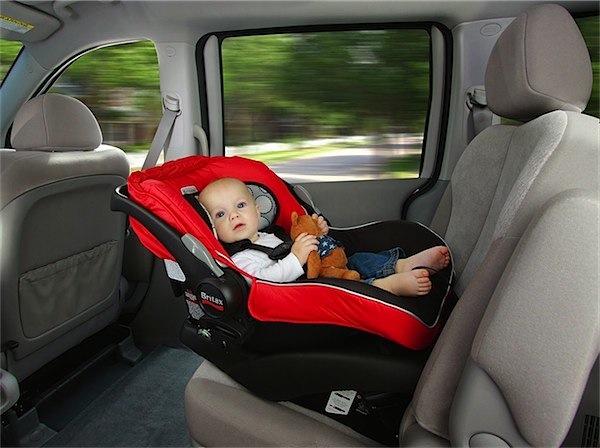
Buying your first car seat can be mega scary – here’s a few tips that you need to read.
Buying your first car seat can be a minefield.
There is so much choice and the prices range so vastly that it can be overwhelming and a real challenge. Your friends will all have different ideas, the shop assistants will tell you one thing, you’ll read another. Like I said, a minefield!
Fortunately, thanks to my work for a major children’s retailer, I have a great wealth of knowledge when it comes to car seats and the rules and regulations surrounding them in the UK. Now, I say the rules and regulations in the UK, but the general principles of good practice are the same all over the world.
Before I go any further, this post isn’t going to tell you which car seat to buy, more give you a good idea of what to look for when you buy and I will also explain the rules around moving on to your next seat.
So here are the things you need to know:
-
All newborns must be rear-facing in the car, and should remain so until the age of 4 – even if you only buy an infant carrier, you SHOULD have rear facing for your next seat.
This means that whether you choose to go for an infant carrier or an extended rear facing car seat, it must face the back of the seat you placing it in until the child is AT LEAST 9 months and 20lbs/9kg in weight, though it is a bagillion times safer if you rear face your child until they are 4 years old or 18kg. The benefit of an infant carrier is that you can take it in and out of the car, and it tends to be a cosier and, ultimately, better fit for a small newborn, although a dual stage car seat (which I personally don’t really like at all) can be turned around to face forwards and will last that bit longer, as will going straight for an extended rear facing seat – saving you pennies in the long run.
-
Think impact protection, impact protection, impact protection!
Impact protection is essentially the padding and technology that has gone into the car seat to protect your child in the event of an impact. Not rocket science, right? I cannot tell you the amount of times I have had people tell me their children look ‘too squished’ or there is ‘too much padding’. Really people, come on! A car seat with a lot of impact protection is better than a car seat without, especially when the impact is focused around the head and neck. The majority of fatal accidents involve head, neck and back injuries, very few people die from a broken leg. That needs to be in your mind when you look at seats.
-
A base for your infant carrier is a plus, for convienience and safety.
There are a lot of mixed feelings out there with regards to bases for your infant carrier. A car seat base can either be seat belted or Isofix (two little prongs in between the back and base of your seat, that physically attach your base/car seat to the cars frame) attached to your car. They are only (for the most part) for infant carriers, something a lot of people don’t realise when they buy one, but, although it makes that initial purchase of this relatively short lived product much more expensive, it IS a safer option that simply belting your infant carrier into the seat. The side to side movement is drastically reduced and the car seat is held in a secure base that can’t move about. Not only that but bases work on a click on/click off mechanism that means you dont have to touch a seat belt and can easily get your seat in or out of the car. No making sure you have done it right, fighting with the shopping bags in the way or a wriggling six month old. Perfect!
-
Don’t be so eager to move on
The guidelines for moving your child to the next stage car seat do vary drastically from country to country, but in the UK, car seat manufacturers recommend that a child must be able to sit up and support their head, unaided, for a minimum of 30 mins, they should be at least 9 months of age (this stipulation has loosened up a bit over the years as weight is a more important consideration) and they must, absolutely MUST, be at least 20 lbs/9 kg in weight. Over the years I have had so many parents tell me that their baby is too big, legs are over growing, don’t like it etc. It doesn’t matter. Keep your child in that seat until they meet those guidelines and, if possible, for longer! In a lot of european countries, it is law that a child is rear facing until they are four years old because in the event of an accident it is safer. I mentioned parents worrying about legs over growing and pushing against the back of the seat, I promise you, this is not an issue. A child has only outgrown their car seat when their head is right at the top of the seat.
-
Lastly, car seats need to be tested in your car before you buy them
Yes, that sales assistant that wanted to ‘test’ your car seat wasn’t joking or trying to encourage you to buy from that store, you do need to have car seats checked for compatibility with your car. You can set your heart on a particular seat, but if it doesn’t fit (and believe me, there are a host of reasons a car seat doesn’t fit) then you really shouldn’t use that seat. The good news is, infant carriers generally fit most cars, as do bases, however you will find that some seats (especially when you get into the following stage of car seats) still need testing. Some of the larger manufacturers have online compatibility guides so you can buy online, but if you visit a store and they don’t mention compatibility or testing, walk out.
I hope this helps you on your search for a good car seat. There are some fantastic manufacturers out there who work tirelessly to bring you the safest seats possible. I have personal experience with Maxi-Cosi and Cybex, although they are by no means the only ones.
Harriet x
Do you have any comments or questions? Please get in touch, I love to hear your feedback and if you have an experiences you want to share please do!


